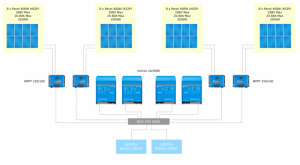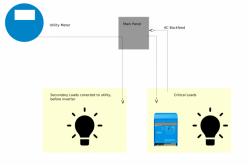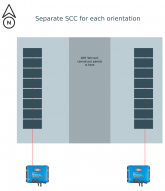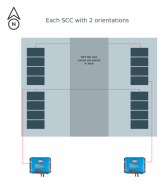mrdavvv
Solar Enthusiast
- Joined
- Jan 14, 2020
- Messages
- 404
Hello!
So im playing with the idea of building a "big" Victron system, but only the 24/3000 model its available and legal for grid tie around here. So probably sticking with a 24V system, like this:

Ive seen that this levels of power are not advice able for 24V systems, mainly for 2 limitations. The conductor sections required are too big, and the batteries need to handle all that amperage without failing. But with a modular system as this, i think both of them can be mitigated.
1.- Consider a big busbar, like this 600A one:

2.- Each inverter its connected to the 24V Bus by independent cables (AWG2 or 1)
3.- Each battery its connected also with separate cables. (Also AWG 1/0, 170A@90c insulation)
4.- Would be limited at 8Kw at the output (By AC breakers and calculated loads), the system its overpaneled and overinvertered just because we can only get this model of inverter, and the solar PV positioning its not ideal, so need more power to offset efficiency losses.
5.- System wont be limited at the input, so we can take advantage of 100% PV backfeed power (Grid tie).
6.- Independent fuses and DC switch's for each battery and inverter, so not need to use too big components.
7.- Considering 8000W max load, we have a maximum of 330A for the battery bank, 160A for each battery. This will be a worse case scenario, since the PV should supply most of the power. The AWG 1/0, appropiate fuses, switch and BMS should handle this.
8.- Will be back feeding to the grid, in this case we can use 100% of solar and inverter power. That would be 400A at the busbar.
9.- Batteries will only be used during nights (Small load) and in case of blackouts. During the day the inverters would be using only PV and Utility power (Pass trough).
10.- Would limit battery charge current to appropiate levels.
11.- Cant limit discharge battery current (Only by the BMS). But less than .5c would be "normal" (Less than 4Kw at the output), and as i mention only during blackouts .
-----------------------------------
So what do you think about this arrangement?, i'm probably missing something important so i would really appreciate any pointers to see if this 10Kw are doable or recommended with 24V dc, or maybe should i just go for 48V (More difficult to source, and would not be able to grid tie, wich would means a lot of $$$ lost.
-----------------------------------
Bonus questions:
- If we have batteries at 100% SOC, a load lets say of 8Kw, and PV its supplying the same 8Kw.... the battery wont be charged / discharged right?. The victron inverters take the 24Vdc directly from Busbar / MPPT chargers, without the battery getting involved at all?
- In a grid tied system. Supose we have some loads before the Victron inverter (Not supplied at all by solar). But still in the same building circuit. If we are backfeeding to the grid, the secundary loads of the diagram would take this energy before the grid?.... the energy send to the grid its only the surplus left after all the building loads?. This would be perfect to put big loads, as A/C or motors at the "input" of the inverter (In parallel), instead of the output (Would requiere an even bigger system!)

So im playing with the idea of building a "big" Victron system, but only the 24/3000 model its available and legal for grid tie around here. So probably sticking with a 24V system, like this:

Ive seen that this levels of power are not advice able for 24V systems, mainly for 2 limitations. The conductor sections required are too big, and the batteries need to handle all that amperage without failing. But with a modular system as this, i think both of them can be mitigated.
1.- Consider a big busbar, like this 600A one:

2.- Each inverter its connected to the 24V Bus by independent cables (AWG2 or 1)
3.- Each battery its connected also with separate cables. (Also AWG 1/0, 170A@90c insulation)
4.- Would be limited at 8Kw at the output (By AC breakers and calculated loads), the system its overpaneled and overinvertered just because we can only get this model of inverter, and the solar PV positioning its not ideal, so need more power to offset efficiency losses.
5.- System wont be limited at the input, so we can take advantage of 100% PV backfeed power (Grid tie).
6.- Independent fuses and DC switch's for each battery and inverter, so not need to use too big components.
7.- Considering 8000W max load, we have a maximum of 330A for the battery bank, 160A for each battery. This will be a worse case scenario, since the PV should supply most of the power. The AWG 1/0, appropiate fuses, switch and BMS should handle this.
8.- Will be back feeding to the grid, in this case we can use 100% of solar and inverter power. That would be 400A at the busbar.
9.- Batteries will only be used during nights (Small load) and in case of blackouts. During the day the inverters would be using only PV and Utility power (Pass trough).
10.- Would limit battery charge current to appropiate levels.
11.- Cant limit discharge battery current (Only by the BMS). But less than .5c would be "normal" (Less than 4Kw at the output), and as i mention only during blackouts .
-----------------------------------
So what do you think about this arrangement?, i'm probably missing something important so i would really appreciate any pointers to see if this 10Kw are doable or recommended with 24V dc, or maybe should i just go for 48V (More difficult to source, and would not be able to grid tie, wich would means a lot of $$$ lost.
-----------------------------------
Bonus questions:
- If we have batteries at 100% SOC, a load lets say of 8Kw, and PV its supplying the same 8Kw.... the battery wont be charged / discharged right?. The victron inverters take the 24Vdc directly from Busbar / MPPT chargers, without the battery getting involved at all?
- In a grid tied system. Supose we have some loads before the Victron inverter (Not supplied at all by solar). But still in the same building circuit. If we are backfeeding to the grid, the secundary loads of the diagram would take this energy before the grid?.... the energy send to the grid its only the surplus left after all the building loads?. This would be perfect to put big loads, as A/C or motors at the "input" of the inverter (In parallel), instead of the output (Would requiere an even bigger system!)

Last edited:





